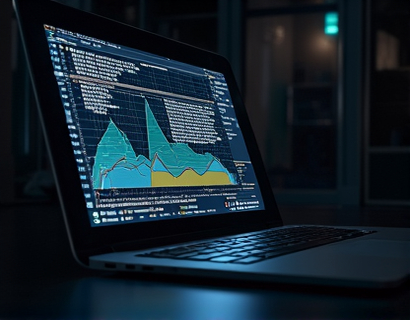Streamlining Digital Asset Management with Advanced Smart Contracts
In the rapidly evolving landscape of digital finance, the need for efficient and secure asset management solutions has become paramount. This article delves into the transformative power of leveraging advanced smart contracts for the creation and management of digital assets, specifically focusing on tokenization pegged to leading cryptocurrencies and digital assets like UCASH. By harnessing the capabilities of smart contract technology, we can significantly enhance the security, performance, and overall reliability of financial ecosystems.
Understanding Digital Asset Tokenization
Digital asset tokenization involves converting real-world assets into digital tokens on a blockchain. These tokens represent a fraction of the underlying asset and can be traded, transferred, and managed digitally. The process of tokenization opens up new avenues for investment, liquidity, and asset management. For instance, UCASH, a digital asset designed to mirror the value of fiat currencies like the US Dollar, can be tokenized to create UCASH tokens. These tokens can then be used in various financial applications, offering a seamless and secure way to interact with the asset.
Advantages of Smart Contracts in Token Management
Smart contracts are self-executing contracts with the terms of the agreement directly written into code. They automatically enforce and execute the terms of the contract when predefined conditions are met. In the context of digital asset management, smart contracts offer several key advantages:
- Security: Smart contracts are stored on a blockchain, which is inherently secure and resistant to tampering. This ensures that the rules governing the token are immutable and transparent.
- Automation: Smart contracts automate the execution of contractual obligations, reducing the need for intermediaries and minimizing human error.
- Transparency: All transactions and contract executions are recorded on the blockchain, providing a clear and auditable trail.
- Efficiency: By automating processes, smart contracts reduce the time and cost associated with manual management of assets.
Creating Tokens Pegged to UCASH
To create UCASH tokens, the first step is to design a smart contract that defines the token's behavior and rules. This contract should specify how the token's value is pegged to UCASH, the issuance mechanism, and the rules for trading and transferring tokens. Here’s a high-level overview of the process:
1. Define Token Parameters: Determine the total supply of tokens, the precision for price calculations, and the algorithm for maintaining the peg to UCASH.
2. Implement Peg Mechanism: Develop a mechanism within the smart contract to lock and unlock UCASH against the tokens. This ensures that the number of tokens in circulation remains proportional to the amount of UCASH held in reserve.
3. Set Up Trading Protocols: Create functions within the smart contract to allow users to buy and sell tokens for UCASH. These functions should execute automatically when the predefined conditions are met, such as sufficient UCASH reserves and market demand.
4. Ensure Compliance and Auditing: Implement features to comply with regulatory requirements and allow for regular audits to maintain trust and transparency.
Example Smart Contract Structure
Here is a simplified example of what the smart contract for UCASH tokens might look like in Solidity, a popular programming language for Ethereum smart contracts:
```soliditypragma solidity ^0.8.0;contract UCASHToken { string public name = "UCASH Token"; string public symbol = "UCASH"; uint8 public decimal = 18; uint256 public totalSupply; mapping(address => uint256) public balanceOf; mapping(address => mapping(address => uint256)) public allowances; mapping(address => uint256) public lastSentFrom; event Transfer(address indexed from, address indexed to, uint256 value); event Approval(address indexed owner, address indexed approver, uint256 value); constructor() public { totalSupply = 1000000000 * decimal; // Initial supply of 1 billion tokens } function mint(address to, uint256 amount) public onlyOwner { require(amount > 0 && amount <= totalSupply, "Insufficient supply"); totalSupply -= amount; balanceOf[to] += amount; emit Transfer(address(0), to, amount); } function transfer(address to, uint256 amount) public { require(balanceOf[msg.sender] >= amount, "Insufficient balance"); balanceOf[msg.sender] -= amount; balanceOf[to] += amount; lastSentFrom[msg.sender] = block.timestamp; emit Transfer(msg.sender, to, amount); } function approve(address approver, uint256 amount) public { allowances[approver][msg.sender] = amount; } function transferFrom(address from, address to, uint256 amount) public returns (uint256) { require(balanceOf[from] >= amount, "Insufficient balance"); require(allowances[from][msg.sender] >= amount, "Insufficient allowance"); allowances[from][msg.sender] -= amount; balanceOf[from] -= amount; balanceOf[to] += amount; emit Transfer(from, to, amount); } // Function to maintain the peg to UCASH function maintainPeg() external onlyAdmin { uint256 ucashPrice = getUCASHPrice(); // Function to fetch current UCASH price uint256 requiredUCASH = totalSupply / ucashPrice; if (balanceOf["UCASH"] < requiredUCASH) { mint(address("0"), requiredUCASH - balanceOf["UCASH"]); } else { transfer(address("0"), balanceOf["UCASH"] - requiredUCASH); } } // Mock function to fetch UCASH price function getUCASHPrice() internal view returns (uint256) { // Implement logic to fetch current UCASH price from an oracle or external source return 1; // Placeholder value } // Accessor functions for events function transferAmount(address indexed from, address indexed to, uint256 value) public view returns (uint256) { return allowances[from][to]; } // Administrative functions function onlyAdmin() public { require(msg.sender == owner, "Not the contract owner"); } modifier onlyOwner() { require(msg.sender == owner, "Caller is not the contract owner"); _; }}```In this example, the smart contract includes functions for minting and transferring tokens, maintaining the peg to UCASH, and administrative controls. The `maintainPeg` function ensures that the token supply adjusts based on the current price of UCASH, maintaining the desired peg.
Benefits of Using Smart Contracts for Token Management
The implementation of smart contracts for token management brings numerous benefits:
- Enhanced Security: Smart contracts eliminate the risk of fraud and manipulation, as the rules are codified and executed by the blockchain.
- Reduced Costs: By automating processes and reducing the need for intermediaries, smart contracts lower transaction costs.
- Increased Transparency: All transactions and contract executions are visible on the blockchain, providing a high level of transparency and trust.
- Improved Liquidity: Tokenization and smart contracts facilitate easier trading and transfer of assets, enhancing liquidity in the market.
- Scalability: Smart contracts can handle a large number of transactions efficiently, making them suitable for high-volume financial ecosystems.
Integrating Smart Contracts with UCASH and Other U Assets
UCASH, as a digital asset designed to mirror fiat currencies, can significantly benefit from smart contract-based tokenization. By creating UCASH tokens, users can interact with the asset in a more flexible and accessible manner. Here’s how this integration can enhance the financial ecosystem:
1. Accessibility: Tokenization makes UCASH more accessible to a broader audience, including those who may not have direct access to the underlying fiat currency.
2. Fractional Ownership: Tokens allow for fractional ownership of UCASH, enabling smaller investments and increasing market participation.
3. Programmable Finance: Smart contracts enable complex financial products and services, such as decentralized finance (DeFi) applications, leveraging UCASH tokens.
4. Cross-Platform Compatibility: Tokens can be used across different blockchain platforms and applications, enhancing interoperability and utility.
Example Use Cases
Consider a scenario where a user wants to invest in UCASH but does not have access to the underlying currency. By purchasing UCASH tokens, they can participate in the market without needing to hold the actual fiat currency. Similarly, a decentralized lending platform can use UCASH tokens as collateral, facilitating peer-to-peer lending without the need for traditional financial institutions.
Challenges and Considerations
While the benefits of smart contract-based token management are significant, there are also challenges and considerations to address:
- Regulatory Compliance: Navigating the regulatory landscape for digital assets is complex and varies by jurisdiction. Ensuring compliance is crucial to avoid legal issues.
- Technical Complexity: Developing and deploying smart contracts requires expertise in blockchain technology and programming languages like Solidity.
- Security Risks: Despite the inherent security of blockchain, smart contracts can have vulnerabilities that need to be thoroughly audited and tested.
- User Education: Educating users about the benefits and risks of tokenization and smart contracts is essential for widespread adoption.
Future of Digital Asset Management
The integration of advanced smart contracts for digital asset management represents a significant step forward in the evolution of financial ecosystems. As technology continues to advance, we can expect:
1. Increased Adoption: More institutions and individuals will adopt tokenized assets, driving growth and innovation in the space.
2. Enhanced Features: Smart contract capabilities will expand, enabling more sophisticated financial products and services.
3. Greater Interoperability: Efforts to standardize smart contract protocols will improve compatibility across different platforms and ecosystems.
4. Regulatory Clarity: As the market matures, regulatory frameworks will become more defined, providing clearer guidelines for participants.
In conclusion, leveraging advanced smart contracts for the creation and management of digital assets like UCASH tokens offers a powerful solution for enhancing security, efficiency, and accessibility in financial ecosystems. By embracing this technology, stakeholders can unlock new opportunities and drive the future of digital asset management.










































